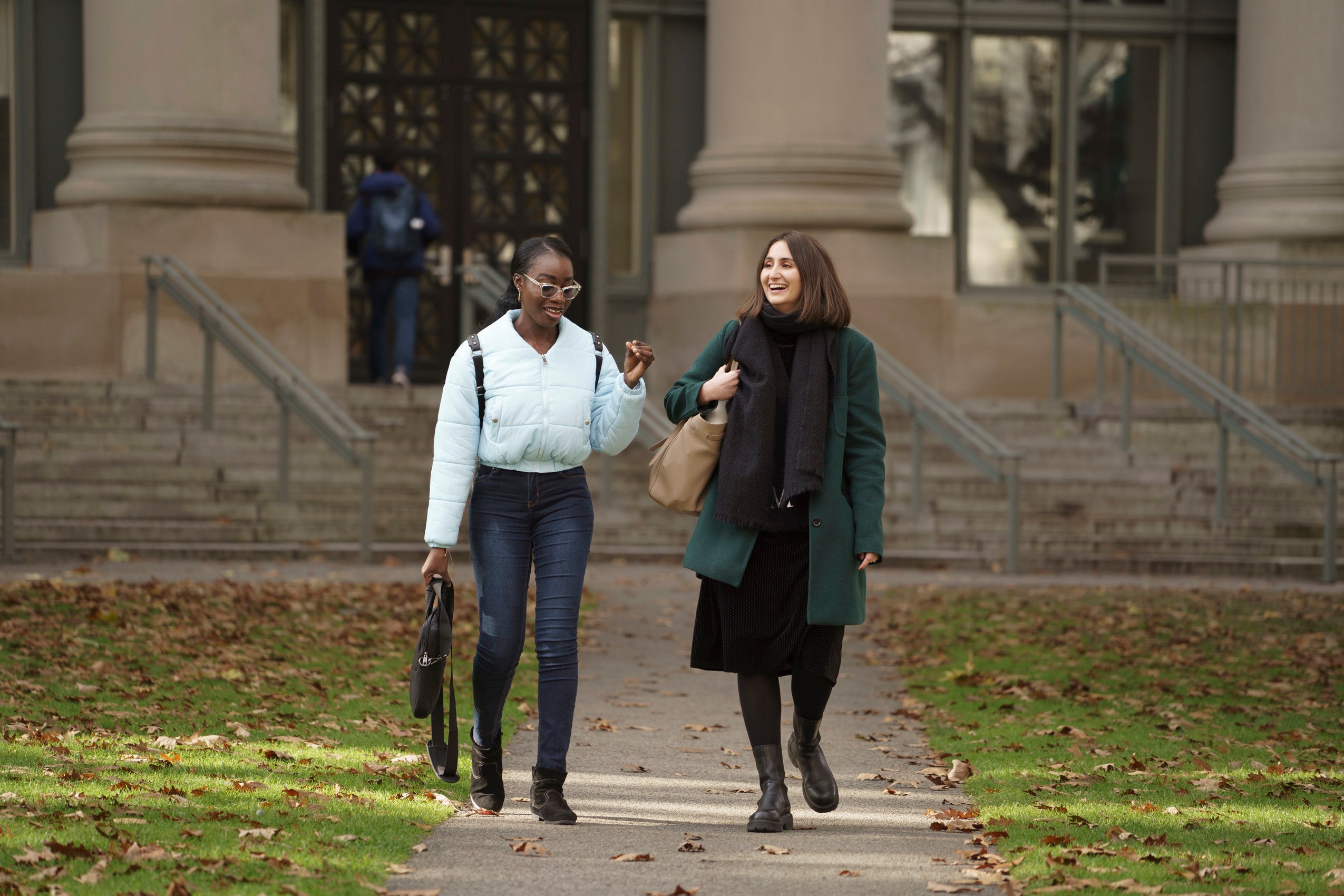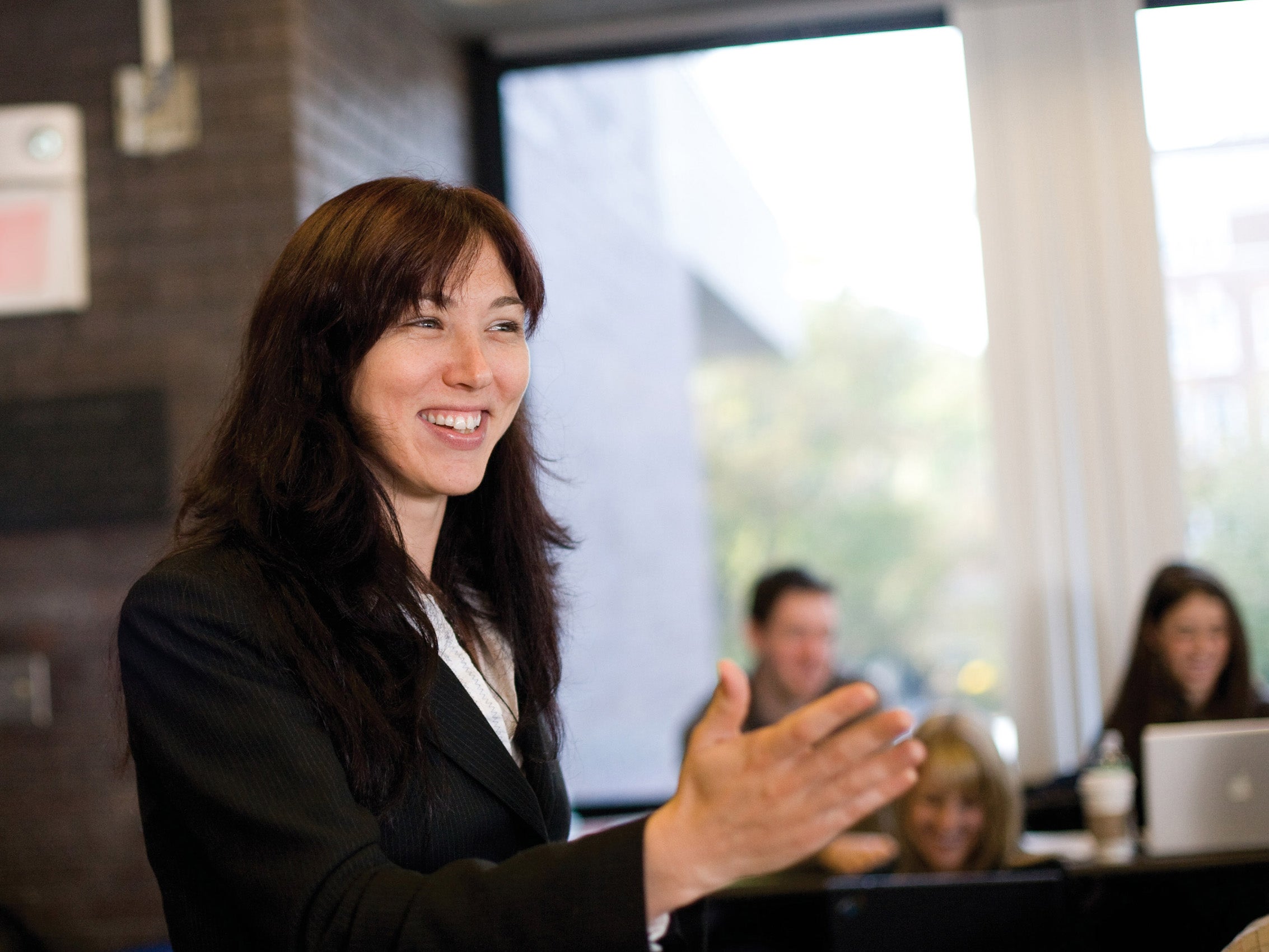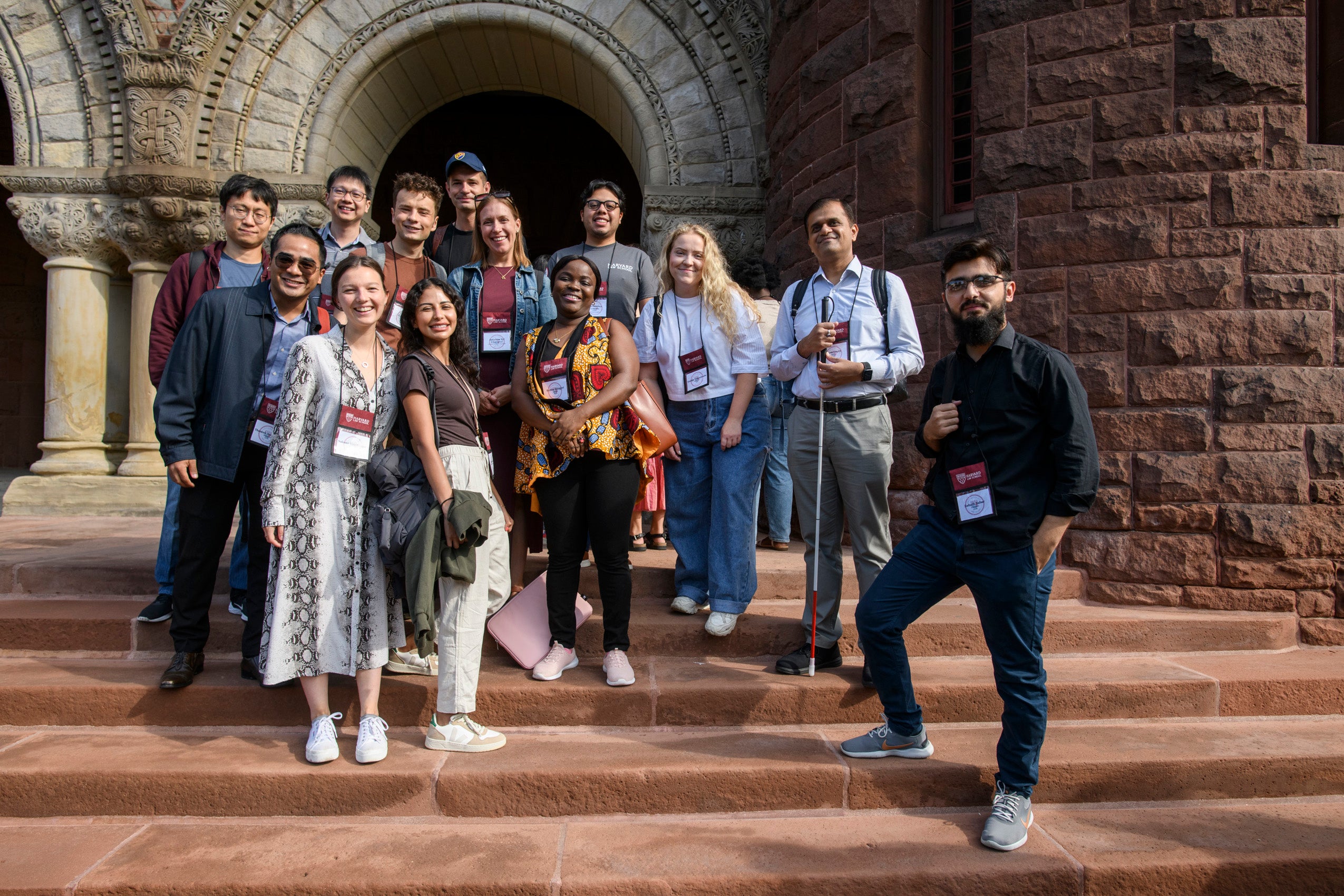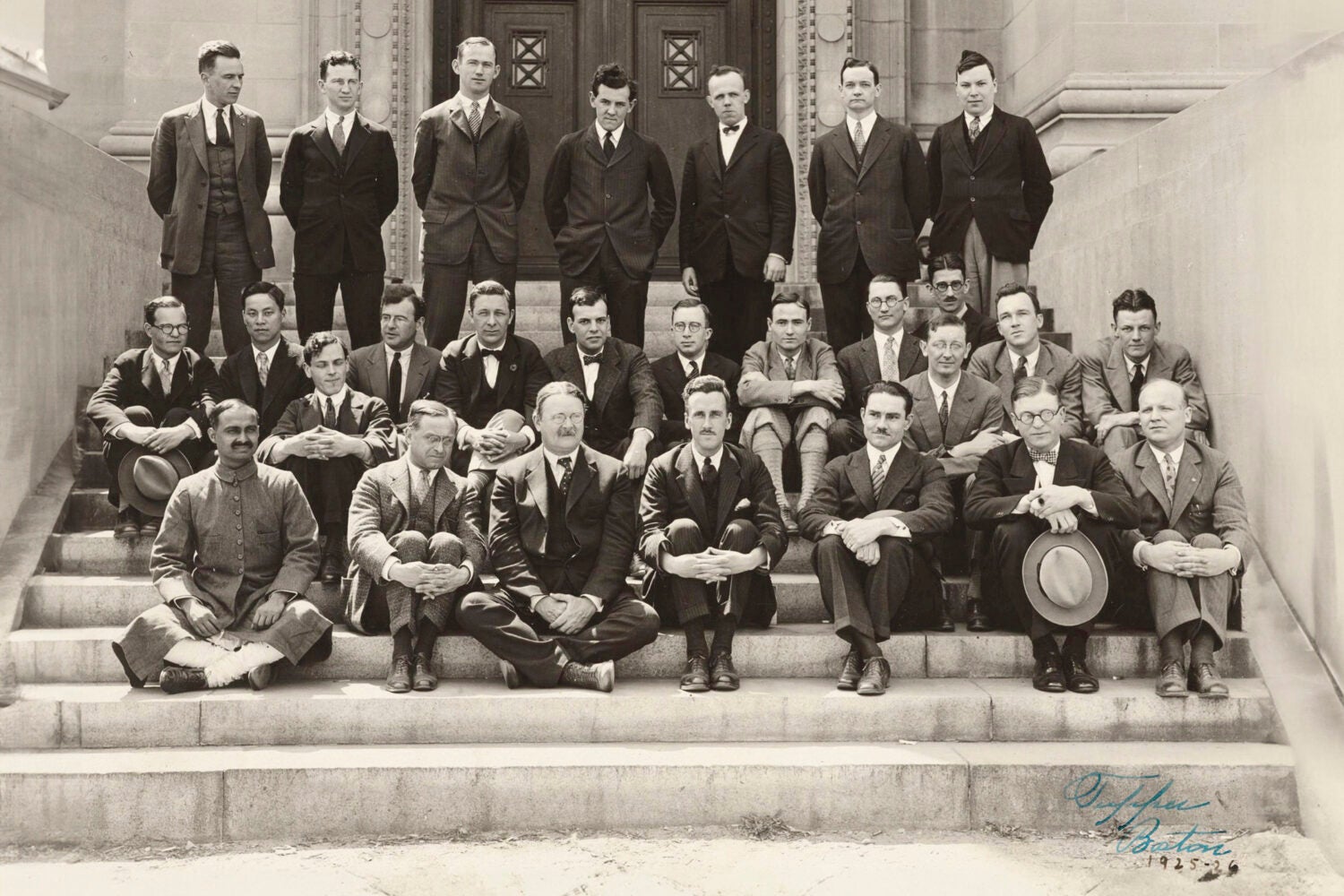Marta Banozic LL.M. ’24, from Croatia, served as an attaché in trade policy during the first-ever Croatian presidency of the Council of the European Union in Brussels, and worked with an Austrian law firm counseling startups. This year, as Harvard Law School commences its celebration of the 100th anniversary of its Master of Laws, or LL.M., program, Banozic is among 180 students in the centennial class, where she’s focusing her studies on corporate law and international dispute settlement.
At a school with nearly limitless options in courses, clinics, student organizations, and extracurricular events, FOMO — fear of missing out — is one of the biggest challenges she says she faces. So Banozic took the advice the program’s leaders gave to her entire LL.M. cohort: Try something you’ve never imagined doing.
Banozic enrolled in Legal Innovation Through Design Thinking, where she’s in a team with two J.D. students working on creative solutions to a challenge faced by an association working in the legal profession. “I’m loving it,” says Banozic. “It’s a special class because you have an actual client you’re designing a work product for.” The J.D. students she meets in this and other courses tell her they appreciate her perspective as an experienced lawyer. “I think both sides enrich each other,” she says.
Banozic’s classmate Ojadamola Kehinde Takuro LL.M. ’24 holds an LL.B. degree from her home country of Nigeria, where she was a lawyer for the largest online savings and investment platform. She came to Harvard Law School to study the American financial system; as a volunteer with the Harvard Law Entrepreneurship Project, one of the school’s student practice organizations, she’s advising a technology startup on its AI software. Harvard Law “is such a great learning experience,” says Takuro. Among the LL.M. cohort, “You see people who’ve achieved so much and yet are so humble and are willing to learn from each other. It’s such an inspiring community to be in.”
These stories — and there are thousands more — illustrate the strengths of the LL.M. program: the range of its educational opportunities and its impressive student body; the students’ love for the program and the opportunities it provides; the close friendships they form; and the benefits their perspectives offer the school more broadly.

“Harvard Law School’s LL.M. students bring not only deep talent, but also rich and varied experiences that have enriched our community for more than a century,” says John F. Manning ’85, Morgan and Helen Chu Dean and Professor of Law. “I am grateful for the many ways our LL.M.s have contributed and will contribute, to our community, to the ideals of law and justice, and to the well-being of the world.”
“I am grateful for the many ways our LL.M.s have contributed and will contribute, to our community, to the ideals of law and justice, and to the well-being of the world.”
Dean John F. Manning ’85
From an initial cohort of four students when the program was launched 100 years ago to offer students an extra year of study at Harvard Law, it has grown in size and scope. Of this year’s class, 98% are international students representing 69 countries and jurisdictions, from Argentina to Zimbabwe.Harvard’s current LL.M.s have held legal positions in private practice, academia, and public service. Of the four American students, three are active-duty JAG officers in the U.S. Navy or Coast Guard. There are 19 Fulbright Scholars; 13 supreme or constitutional court clerks for courts in Canada, Colombia, Ecuador, India, Israel, Mexico, Nepal, and Singapore; four prosecutors; and four full-time law teachers. Fifty-three percent are women. The cohort includes a former national chess champion, an opera singer, a former professional soccer player, a stand-up comedian, and two published novelists, including Takuro.
The LL.M. program admits students irrespective of financial need — their ability to fund their education is not considered — and it also provides need-based financial aid so that everyone admitted can afford to attend. As a result, “this is quite literally the most diverse community you can imagine, and diverse not just along the dimensions of national origin or state of education but the lived experiences of people coming from all kinds of backgrounds, with all kinds of perspectives, and career aspirations,” says Gabriella Blum LL.M. ’01 S.J.D. ’03, the Rita E. Hauser Professor of Human Rights and Humanitarian Law and vice dean for the Graduate Program and International Legal Studies.

“This is quite literally the most diverse community you can imagine,” says Gabriella Blum, HLS professor and vice dean for the Graduate Program and International Legal Studies. Credit: Michael Malyszko
Over the past century, “a number of alumni have been quite consequential in government, the judiciary, private practice in leading firms, business, and NGOs and civil society around the world,” says Professor William P. Alford ’77, director of the East Asian Legal Studies Program, who served as vice dean for the Graduate Program and International Legal Studies from 2002 to 2020. Along with Jeanne Tai — who retired in 2021 after decades at the program, including as assistant dean — Alford, who remains senior adviser, was instrumental in expanding the program’s size and scope, and in recruiting students from sub-Saharan Africa, China, and other jurisdictions with historically lower representation in the program.
Today, the program’s approximately 6,500 living alumni include, among a myriad of other graduates who have made their mark on the world, Mary Robinson LL.M. ’68, the former president of Ireland who also served as United Nations High Commissioner for Human Rights; Rubén Blades LL.M. ’85, a world-famous musician, actor, and politician; Koen Lenaerts LL.M. ’78, president of the Court of Justice of the European Union; HRH Princess Sonam Wangchuck LL.M. ’07, a princess of Bhutan, who is founding president of the Bhutan National Legal Institute; and Ayesha Malik LL.M. ’99, the first female justice of the Pakistan Supreme Court (25 HLS LL.M.s serve on the highest courts of 18 countries worldwide).
“The LL.M. class has the most interesting, intelligent people from around the world. They are such a phenomenal part of the school,” says Salvo Arena LL.M. ’00, managing partner of the New York office of Chiomenti, an international law firm. Arena arrived from Sicily with a law degree, a Ph.D., and an M.B.A., looking to study the law of hostile takeovers with three of the world’s leading experts — Professors John Coates, Lucian A. Bebchuk LL.M. ’80 S.J.D. ’84, and Reinier H. Kraakman. “We learn the American legal process, the Socratic method, and of course we are exposed to the sophisticated legal minds of the J.D.s,” he says. “But we give back so much in terms of diversity of our different legal and cultural backgrounds.”
“It’s a very energetic atmosphere,” says Banozic, “one that suggests that anything is possible, that people with such ideas can change the world.”
One hundred years and counting
In 1910, Harvard Law School established the Doctor of Juridical Science, or S.J.D., program to offer advanced degrees primarily to lawyers interested in teaching law. But other students, not necessarily planning to become academics, also wanted to spend an extra year at the school.
In 1923, Harvard Law instituted a one-year LL.M. program primarily for J.D. students planning to practice law. The first full cohort, the Class of 1924, comprised four students: an American military JAG officer; two Canadians, one who became a renowned international law expert in Canada, and another who went on to earn an S.J.D. and teach at George Washington University Law School; and a Filipino who later served on the Supreme Court of the Philippines. Within 10 years, the LL.M. program had conferred 86 degrees, including to 28 students from China, Guatemala, the Netherlands, and Peru, among other countries.
In 1950, Professor Paul A. Freund ’31 S.J.D. ’32, chairman of the Committee on Graduate Studies, advised that because political leadership around the globe tended to come from those trained in law, Harvard had a “special responsibility” to offer meaningful legal education to graduates of foreign law schools. Dean Erwin N. Griswold ’28 S.J.D. ’29 agreed, and by 1957, the program included 89 students from 31 countries. Many were attracted to the school’s new International Tax Program. In addition, the school launched International Legal Studies, or ILS, which offers a wide variety of international research and study opportunities for all HLS students, complementing the huge array of international and comparative law courses available at the school.
“It’s a very energetic atmosphere, one that suggests that … people with such ideas can change the world.”
Marta Banozic LL.M. ’24
In the 1970s there was an effort to promote the LL.M. to American as well as international students, as the latter continued to grow in numbers. By the early 2000s, the program had grown to its current size of about 180 students.
Today, as a result of the law school’s financial aid policies, its students hail from a broader range of backgrounds than those of any other school. “We have people from the six continents and that is a very major commitment in terms of financial aid,” Alford says.
The program puts an emphasis not only on educational experiences but also on building community both within the LL.M. class and by integrating the graduate students into the larger law school community.
“It’s important for us to build cohesion within the LL.M. cohort, and that’s something we prioritize as a program,” says Blum. This year the conflict in the Middle East is presenting particular challenges. “Whatever happens in the world,” she says, “is going to affect the students who are here, either directly and personally, because they come from those communities, or because they feel very strongly about the issues.”
“The students’ emotional bond to the law school is a very intense one,” says Alford. “This is often a transformative year in their life. … You see how much the opportunity means to them and how well they’re taking advantage of it.”
Catherine Peshkin, assistant dean for the Graduate Program and International Legal Studies since 2021, is putting emphasis on building a deeper sense of community between LL.M.s and J.D.s, and has worked closely with the Dean of Students Office on a range of additional cross-program social events, such as a 1L/LL.M. picnic held at the beginning of the year and a World Cup soccer tournament watch party. The Graduate Program has also launched an electronic newsletter for LL.M. and S.J.D. alumni, World Class, which features student and alumni profiles and other news as yet another way to keep alumni across class years and programs informed and connected.

A group of LL.M. students at orientation this fall. This year’s cohort hails from the U.S. and 69 other nations and jurisdictions. Credit: Tony Rinaldo
A global perspective
LL.M. students on average are older than J.D. students and arrive with law practice or teaching experience, perspectives that are invaluable to classroom discussion, says Arena, who has served as president of the Harvard Law School Association, which serves more than 38,000 alumni worldwide, and who is now president of HLSA’s New York City and Europe chapters. “They come from different backgrounds — not only legal backgrounds, but social and cultural and family backgrounds from each part of the world,” he says, “so the contribution they give to J.D. students is very important.”
There is growing recognition of the benefits that LL.M. students bring to the school, says Blum. “I think what we’re now seeing is a greater appreciation.” Today’s J.D.s are more global in their mindsets and eager for international perspectives than when she was a student some 20 years ago, and as American law students grapple with current political issues, such as the allocation of power between courts and legislatures, “I think talking to students from around the world becomes much more relevant,” Blum says.
More than half of the law school’s faculty is involved with the S.J.D. program, and an even greater number with the LL.M. program, “and that’s good for everyone,” says Alford, who notes that nine members of the current Harvard Law faculty, including Blum, are alumni of the LL.M. program. “A ton of colleagues tell me what a joy it is having the different questions and perspectives from the LL.M.s,” he says.
Given the critical role financial aid plays for so many LL.M.s, financial aid funding is an important priority. In addition to institutional funding, the Graduate Program relies on donations including from LL.M. alumni, and there will be a dedicated giving fund for the 100th anniversary, Blum says. Additional funds will not only continue to make it possible for all those admitted to attend the program regardless of need, but also enable the program to expand J.D./LL.M. community building initiatives and offer more postgraduate internships for all HLS students in international settings, as growth of International Legal Studies is one of Blum’s priorities.
Nora Estefanía Picasso Uvalle LL.M. ’19, who is from Mexico, worked on gender equality and abortion rights issues in Colombia before matriculating at Harvard Law, which she attended with the support of substantial financial aid and loans. Like Banozic, she took the advice of the program leadership to try something outside her area of expertise and volunteered with the Harvard Law School Immigration Project, another of the school’s student practice organizations. She found it so rewarding that she switched her career trajectory, enrolling in the Harvard Immigration and Refugee Clinic, where she directly represented clients. Today, she runs a project at Capital Area Private Defender Service in Austin, Texas, educating defense lawyers on the immigration consequences of criminal charges to their undocumented clients.
Blum says it’s students and alumni like Uvalle who give the program its strength, vitality, and international reach — and they’re why so many administrators and staff stay for years or decades, working to expand and improve it, and develop friendships with students that go on long past graduation.
“There is something about the energy, the passion, the excitement of working with this particular student body,” says Blum, “that is incredibly fulfilling.”
